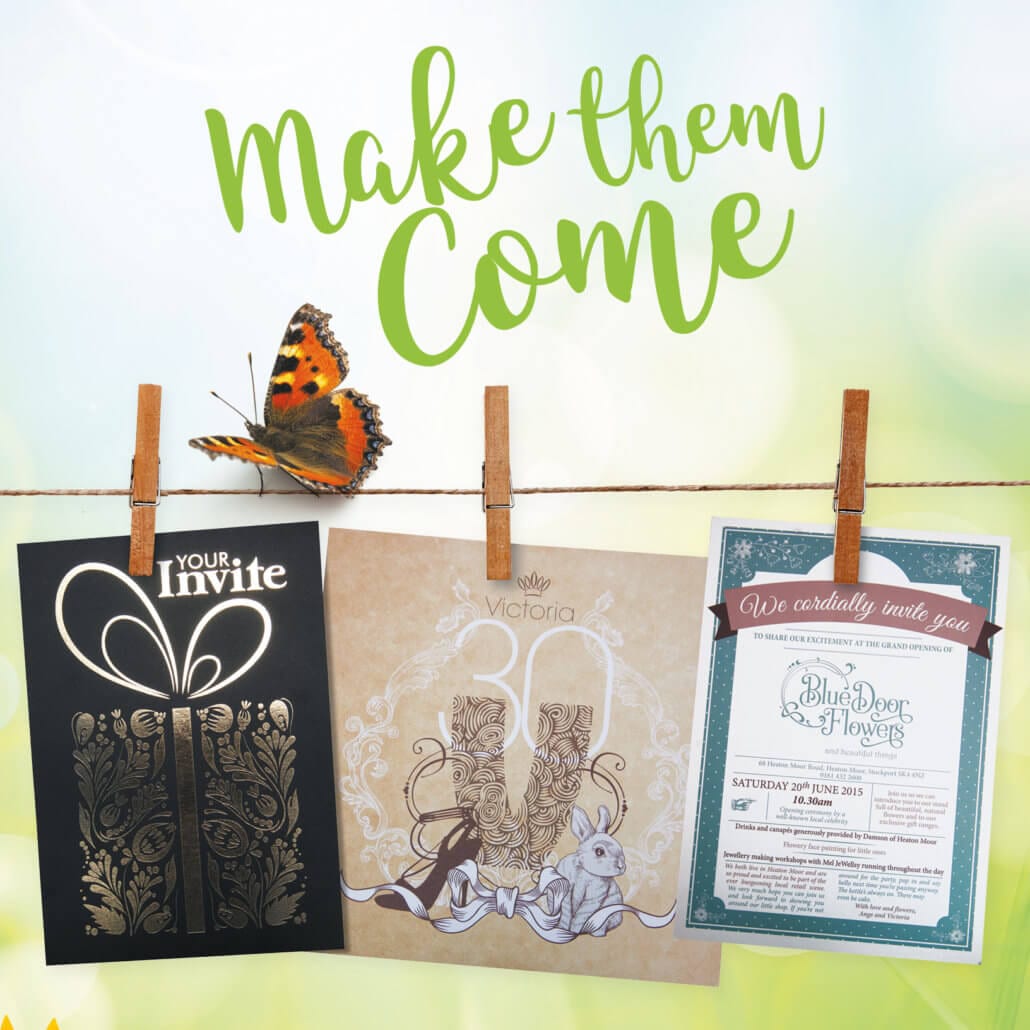November and December are peak months for many businesses. We’ve got some fancy new products and some seasonal favourites on offer to help you win extra business. This is your time to shine…
Getting your business ready for the new GDPR rules can be overwhelming. It’s a lot to take in, we know. That’s why we’ve put together an interactive online flowchart, guiding you through some steps you need to take.
If your business uses email marketing, sends direct mail or makes sales calls, the law is changing what you can and can’t do.
Google have announced that, from October, there will be two new triggers for Chrome’s ‘Not Secure’ warning. Here’s what you need to know, and how to make sure your website isn’t affected.
It’s exhibition season. Are you showing off to new customers? Deciding to exhibit is one thing. Making people notice you is another. How do you make them stop?
You’d be forgiven for thinking that selling online is a different kettle of fish. Truth is, although it may be a different kettle, the fish are pretty much the same.
We’ve been exploring how getting the most out of selling online shares an awful lot of practices and philosophies with good old fashioned bricks and mortar commerce. Up ’til now, we’ve discussed:
Part 1
• Merchandising your online store
A guide that explains the similarities between a good retail display and showcasing your swag online.
Part 2
• Building credibility and establishing trust online
There are lots of indicators in the real world in regards to trust. This article explains what we can do to send out the same reassuring signals online.
Part 3
• Focusing on user experience to increase customers and conversions
User experience originates from the real world around us but here are 5 website specific UI/UX tips to help you get some quick wins on the board.
All of the above are incredibly important areas to consider when setting out your online stall. But the fact remains, however convincing your website is… however wonderful your web shop is… it will be a fantastical flop – if no one knows about it.
Part 4 (That’s this one)
Attracting customers

Optimise (SEO)
Everybody wants to be number one on Google. The reality is, it requires a large ongoing budget and significant resource.
Laying the foundations for a search engine friendly site should be your starting point if you’re serious about the future rankings of your website. Search Engine Optimisation (SEO) is complex and ever changing. Put very simply, it’s about relevance and authority.
Relevance, or on-page SEO, is all about whether search engines can find information on your site that is relevant to the user’s search term. Authority, or off-page SEO, is how much search engines trust your website and determines where you rank.
The rules for both are varied and complex. They change regularly according to the search engine and its algorithms. You can start by making your site relevant to what your audience is searching for.
- Optimise your site’s content in a structured way.
- Help search engines identify the relevance of your pages.
- Identify keywords based on search volume.
- Balance keyword targeting with usability and user experience.
Talk to us about how you can make your site more relevant.

Paid search (PPC)
The adverts you see at the top of Google search results are paid-for adverts. They are a way of driving traffic to your website instantly.
Increasingly for transactional websites and local searches, Google Adwords campaigns are used to push traffic. Google Adwords focus on specified keywords that your customers are currently looking for online. As a Google Partner, we are an approved agency that help tailor and manage these online advertising campaigns for you.
We can advise you on budget, advert content and the best approach to ensuring your business gets found by customers.
With pay-per-click advertising, you only pay when someone clicks on your advert and visits your website. How much you budget daily, weekly, or monthly is up to you.
- Research the market’s keyword demand to learn which to target.
- Long-tail keywords may produce less traffic but they can convert better.
- Measure your success. By seeing which ads get clicked and which don’t, you’ll see where to invest.
Book in a for a free consultation to learn more.

Email marketing
The right message, to the right person, at the right time and in the right place across all devices.
An effective way to re-market to your customers is via email marketing. It’s important to send a combination of both general and focused emails as clients respond differently to both. The way it looks, what you say and a clear call to action all will impact on a campaigns’ success.
However, the starting point of any promotion, in any industry, is how well you collect and maintain your client data. If your ultimate goal is for clients to contact you then this needs to be the focus of your website journey. Collecting data in the right way is as important as receiving the enquiry itself. This information allows you to re-market to your clients in a targeted way.
We are experts in designing e-shots for maximum impact and then reporting back on their effectiveness.
- Offer something of perceived value, like vouchers or ebooks, in exchange for email.
- Email marketing is something that should be done regularly.
- Use with other forms of online and offline marketing to maximise return.
- Use campaign specific landing pages on your website to test their effectiveness.
Book in a for a free consultation to learn more.

Blog
Another popular hotspot for visitors are blogs or latest news sections.
Google likes fresh, new, relevant content, but so do real people! Sure, a lively blog will help your search engine rankings but it will also indicate that you’re open, active and on top of your game.
Blogs are great for attracting new visitors and increasing email subscriptions, helping to build that database of potential suitors.
Frequent updates will encourage users to come back for more, it can help position you as an expert in your field, and it will create the confidence that leads to web enquiries.
- Keep blog posts going out at consistent, regular intervals, so visitors can know when to expect new content.
- Do or do not – there is no try. A blog feature on your website, with no news in the last 6 months looks terrible and could actually be detrimental compared to none at all.
- Give before asking to receive. It’s ok to use a blog post to promote your products and services. But don’t always be selling. Provide plenty of valuable, useful content, for free.
Speak to us about our monthly concierge services that can publish fresh regular ongoing content onto your blog, and keep everything up to date.

Print and direct mail
With the emergence of different online media for promoting your business, offline marketing still offers some of the best return on your investment.
Mail shots, handouts and magazine inserts are just some of the ways offline marketing can get in front of your customers. We offer a varied range of printed products meaning that we have something for everyone. We can help plan, design and print your campaign.
Your online marketing will not be as effective if it is not backed up by offline marketing.
At the end of a client meeting, a networking event or a presentation, you can’t leave your website behind. You need to leave a lasting positive impression using tactile printed collateral such as business cards, leaflets, hand-outs, company brochures and folders.
We have lots of ideas and experience on how to use print to promote your business and drive traffic to your website. Let’s talk.

Engage with social media
To win in web, you have to be there whenever your consumer needs you, to listen to the things they like and to react to the things they don’t.
It’s all about the ‘micro-moments’. Potential customers will need to engage with your business across lots of different channels and devices before taking the next step. You need to be ready to connect with them in whatever medium they want to communicate.
Engaging can build lifelong customers. So what are the routes to engagement for your business?
Being present on social media channels is the first step. Facebook helps you show off the good things you do, Twitter helps you listen to your target demographic, answer questions and join relevant conversations.
- Start building brand advocates with likeable and shareable content.
- Pick up the phone and talk to your clients or engage with them at networking events.
- Regularly write and publish blog articles.
Everything we do is about helping you to engage. For more information on social media management, arrange an appointment.
We all need to be where our customers are. That’s online and offline. It’s at exhibitions and events. It’s selling via ecommerce and persuading, face-to-face. Peak season is coming. Get ready to get busy.
Are you planning any outdoor events this summer? Get maximum exposure for your brand with low-cost outdoor displays. Our 52-page Outdoor Display Ideas Look Book has loads of ideas for this year’s summer season. Get your free copy now!
What is User Experience and why should I care?
UI/UX has become a bit of a buzzword online lately. But user experience doesn’t apply solely to online. Far from it, UI/UX originates from the real world around us.
UX stands for User Experience, another term for customer experience really. Only ‘user’ is broader, as ‘customer’ implies the user has bought something (or is at least there to browse/buy).
“User experience” encompasses all aspects of the end-user’s interaction with the company, its services, and its products.
It is everything! When making a purchase from a bricks and mortar store, it’s:
- Advertising
- How easy it was to find the store
- Traffic and parking
- The shop
- Friendly, helpful staff
- Product range
- How easy it was to find what you wanted
- Pricing
- Product advice
- Queues at the checkout
- Whether the box fits in the car
- How easy the product was to assemble
- How easy the product was to use
- Aftersales service
We could go on.
In that sense, it’s a lot like branding. Some people think a brand is just a logo. But it’s much more than that.
Redefining online sales
In 1999, Zappos founder Tony Hsieh tackled the seemingly impossible – selling shoes online. After all, 20 years ago the preference was to try shoes on for size. Who is going to buy them online?
But now Zappos are one of the largest online shoe retailers in the world. How? By providing an etail experience that rivalled the traditional retail experience. They already had some advantages:
- A far larger range of footwear then your average store.
- The convenience shopping from home brings vs going into town.
By defining a whole new level of customer service (the stories of just how far they will go to make a customer happy are legendary), and offering a remarkable approach to returns (unlimited free delivery AND returns), they really changed the game.
So there’s a big difference between ‘User Experience’ as a whole and improving someone’s experience while on your website. Having said that, it’s a fundamental part that’s increasingly becoming one of the most important parts of the cycle.
So here is some website advice to help you get some quick UX wins on the board.
Easy peasy lemon squeezy
Everyone will tell you the site needs to be simple, and easy to use. That’s a given.
But this becomes even more important when your customer is using their phone. Mobile commerce now accounts for 36% of UK retail sales. And more people than ever are making bookings and reservations while on the go.
So the first thing to address when tackling ‘is it easy to use?’ is the mobile experience.
If the text is too small to read, the buttons and links too fiddly to click, then this needs to be fixed. If you have to pinch and zoom to find your way around then count yourself out.
A responsive website will reflow and resize the content so your happy shopper can thumb through the steps. No hassle, fuss or bother.

“Did you find everything you were looking for today?”
It should be easy to find what you’re looking for. That applies whether it’s the product you pine for or the data you desire.
Just like a good SEO strategy, your user experience journey starts by focusing on the needs of the user.
Giving the customers what they want is a pretty good idea in business, full stop. But how do you know what they want from your website? You can start in four very simple ways.
- Asking your customers
- Seeing what questions you receive from the website
- Checking user flow in analytics
- Studying search data with search analytics report
Combining this knowledge will give you great insights into user intent.
- Why are people visiting your website?
- What are they hoping to find?
- What are they looking to do?
This will not only enable you to deliver the right kind of content, but will also help you map out the journey through the website. ‘Findability’ isn’t just a search box, it’s about guided exploration.
Like VIP guests arriving on a Hawaiian island, visitors should be gently guided so that they can flow seamlessly through each phase. Flower necklaces, effortless check in, let us take your bags, there’s the watersports guy, cocktails at the bar.

Ecommerce experience tips
Following on from findability, almost equally as important in terms of ecommerce is getting customers over the line. Here are five easy ecommerce tips to help improve this aspect of the online customer experience.
1. Transparent Delivery Charges
When you’re in the supermarket with a basket of groceries, you don’t tend to pop it down on the floor and walk out. That would be a bit bonkers. But people do this online. All the time.
And the #1 reason for cart abandonment? Adding extra costs at checkout.
Be as transparent about your delivery charges as possible. If you offer free delivery over £xx then place this message site wide in a prominent position.
Getting this right will encourage people to actually spend more with you, rather than dropping their basket. Learn more about how to set out your online store.
2. Click & Collect
Customers like to know an item is in stock before leaving home. They also don’t like to wait (or pay) for delivery. This explains why Click & Collect has become so popular.
Across all major retailers, over half are already offering Click & Collect, with many more planning to add it this year.
According to Internet Retailing magazine, more than 60% of Click & Collect shoppers go on to purchase further products during item collection.
3. Wishlist
Life’s not always black and white. The reason someone might remove an item from their basket could be down to a number of things. Often, it’s not a cold hearted change of mind, but instead it’s just not the right time.
By offering the ability to save the item, or add to wishlist, you provide an alternative that’s mutually beneficial.
You make it easier for the customer to return and buy the item at a later date. (This is also an acceptable reason to ask that they make an account). You also create a more casual browsing experience as wishlists subconsciously require less commitment than an ‘add to basket’ action.
4. Easy checkout
As well as appearing credible, it’s essential to make it as easy as possible for your customers to complete their purchase.
Forcing people to fill in boxes with their details in order to buy something is a major conversion killer. Reminiscent of those 80’s department stores that required you to have an account before buying from them. Remember them? No? Exactly!
So one of the most significant improvements you can make is to allow customers to checkout without requiring an account. You can always give them the option to create an account afterwards.
5. Thank you, come again
After the payment has been processed, you should redirect your customers to a page thanking them for their purchase. But don’t stop there, improve the customer experience by providing helpful links such as
- What happens next
- Create an account
- Track my order
- Product recommendations
Or make the most of this opportunity to interact with an engaged customer:
- Make it easy for them to share their recent purchase on social media
- Ask them to review their experience
- Encourage newsletter signup or competition entry
- Offer a limited time voucher on their next purchase
The best websites are never finished
They are living, growing things that need to be continually reviewed, updated and improved. Ask about how our concierge packages can help you to define the ultimate user experiences for your customers.
Foiled stamped flyers create a striking impression – stand out and strengthen your brand credibility.
Nettl.com of Liverpool incorporating printing.com take a thick 400gsm board, apply an ultra smooth luxury matt laminate finish and top it off with metallic gold or silver foil highlights. If you want to make an amazing impression and to stand out with something really special, then our Opuleaf Luxe Foiled Showcards are for you. Contact us today for your free samples.


